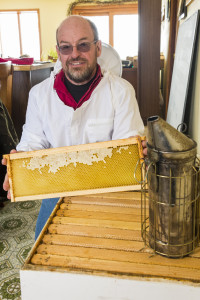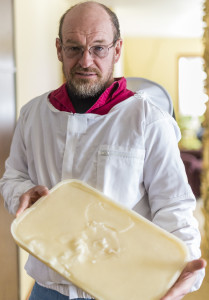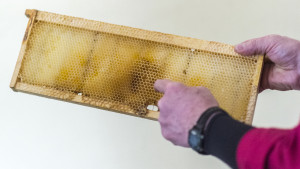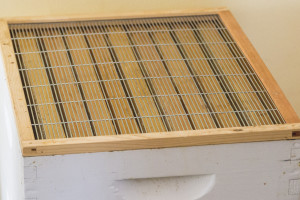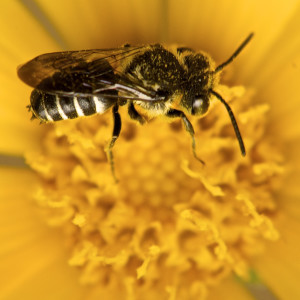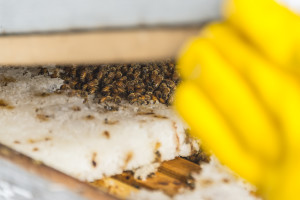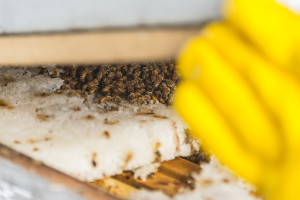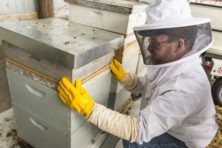The Bees Knees
- Share
- Tweet
- Pin
- Share
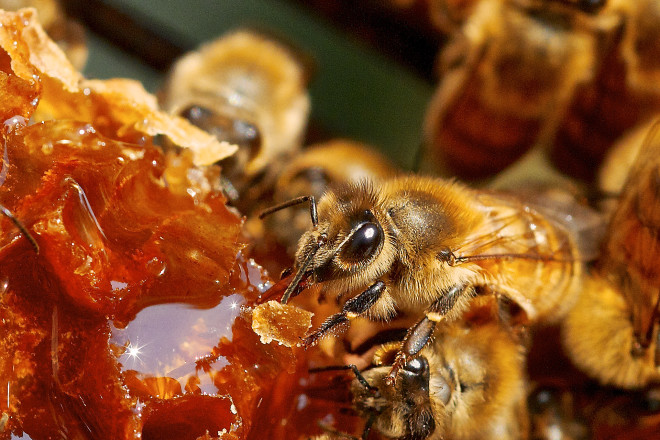
In Volume VI of Wisconsin Beekeeping, dated February 1929, Sturgeon Bay resident Herman Riechard writes, “I think that beekeeping is very good for the orchard man; as the bees help pollinize the cherry and apple bloom. I had fifteen hives of bees in 1927 and my orchard and those of my near neighbors yielded more fruit per acre than those that were a mile or more away.”
Riechard, a self-proclaimed “beginner in beekeeping,” saw the service that his beekeeping provided to a county that depended on successful orchard crops. Today, cherry and apple orchards account for 3,200 acres of land and $5 million of the Door County economy.
Nearly a century later, many other Door County residents have embraced the task of providing pollination to the peninsula, whether they know it or not.
Max Martin got his start beekeeping by problem solving with potato seeds at the Peninsular Agricultural Research Center in Sturgeon Bay.
“I work on wild potatoes. We keep the true seed but we increase it. We hand pollinate all of it,” said Martin. “I thought, ‘Man there’s got to be a better way to pollinate this other than someone literally sitting there pollinating hundreds, sometimes thousands, of flowers by hand.’ I thought, ‘I’m going to try honeybees.’ I called the local beekeeper and Paul Eggert brought a frame of honeybees out.”
Martin explained how the honeybees didn’t touch the potatoes because there was no nectar in them. The bees just clustered by the corners of the enclosed potato room trying to get out.
“He then brought me a box of bumblebees, we put them in with the potatoes and they just pollinated. Bumblebees are not that interested in nectar but they’re very interested in pollen and they’re a bigger bee so they can handle the heavy pollen. So the bumblebees just went nuts,” said Martin.
Paul Eggert became Martin’s mentor and last year, Martin harvested more than 1,000 pounds of honey for sale and for his favorite lunch, peanut butter and honey sandwiches.
As the weather warms, bees are building up their hives for another season of pollination and honey production. Beekeepers like Martin and dozens of others in the county help the bees grow their colonies while getting paid in honey.
Yet this deal has become stressed since the 2006 discovery of Colony Collapse Disorder (CCD), which has caused the unexpected death of millions of honeybees throughout the country. The cause of CCD is unknown but believed to be associated with poisoning from pesticides, genetically modified crops, and pathogens that spread quickly through a packed colony.
The threat has already led to a two-year ban on neonicotinoids, an insecticide linked to CCD, throughout the European Union in 2013 and similar initiatives in the United States. The 2014 Farm Bill will provide emergency assistance to “eligible honeybee losses,” including loss due to CCD, in excess of normal mortality.
The leading theory on CCD deals with varroa mites and their parasitic effect on bees. These mites were introduced to the United States in 1989.
“If you talk to older beekeepers, they never had to treat for these diseases but in the 1980s a lot of people got out of beekeeping because they had all these diseases,” said Martin. Today, Martin frequently performs simple tests on his hives to check for varroa mites and other diseases.
Although the massive death of honeybees might cause a price hike in honey, the greater importance lies in honeybees’ inability to pollinate as much. Almond trees are completely unable to self-pollinate without bees and most other blossoming fruit relies on it. Honeybees pollinate more than $15 billion worth of American crops each year.
Pollination is the process of the anther (male part) of a flower being transferred to the stigma (female part) of another flower, thus providing grounds for reproduction. While bees are the most productive pollinators, pollen can be spread by birds, a gust of wind, or a child running through a field of daisies.
When a honeybee lands on a flower to gather pollen and nectar for the hive, some of a flower’s pollen clutches to its hairy legs and gets carted off to the next place the honeybee lands. It is then deposited, allowing for the receiving flower to reproduce. Flowers have adapted to become more colorful and aromatic to entice a bee to land and pollinate.
While pollination may be the most important asset bees provide to agriculture, it’s not the reason they travel in the first place. They are simply looking for food.
Bee bread, honey and royal jelly are on the menu for any honeybee hive. Bee bread is a combination of pollen and honey that provides the main source of food for a hive. Pollen provides all essential nutrients a bee needs to survive – carbohydrates, protein, vitamins and minerals. Honey, or nectar with most of the water evaporated, is stored in the hive as food throughout the winter while there are no flowers to forage pollen from.
Worker bees also secrete a white gel substance called royal jelly to feed the queen bee and the first meals of new bee larvae. By consuming royal jelly exclusively, the designated queen bee grows larger than the rest in the hive and also grows reproductive organs, allowing it to lay eggs.
A queen bee in a honeybee colony can lay up to 2,000 eggs each day for nearly five years. The new bees are cared for by the worker bees, which are also tasked with cleaning the hive, feeding the young, and foraging for nectar.
When a bee draws nectar out of a plant, it is stored in its belly. Upon returning to the hive, the bee transfers it to another worker bee that begins evaporating the water. Nectar’s 80 percent water content must be evaporated before it turns into the thick consistency of honey. Bees fan their wings to speed up the evaporation process before depositing it into gridded cells called honeycomb. The honeycomb is covered with wax until it is needed as food for the winter season.
A colony typically needs 100 pounds of honey to survive through the winter. In northern Wisconsin, beekeepers stop extracting honey on the first of September, allowing for the hive to build up stores for the winter. With the introduction of CCD, fewer bees are returning to their hives with bellies full of nectar and the hive does not have enough honey to survive the winter.
But if a hive can thrive, beekeepers reap benefits by means of honey sales. Beekeepers harvest the remaining honey in a hive that is not needed for the bee’s survival.
“I generally steal heavy,” said Martin, who harvests more honey than bees can afford to survive through a winter. To compensate, Martin cooks a thick block of white “candy,” a combination of sugar and corn syrup, for the bees to feed on.
Most beekeeping in Door County is done recreationally with the added benefit of honey surplus for roadside sales or farmers markets. Although the honor system at a vacant stand on a rural county road may appear as a convenient yet unproductive business practice, direct farmer-to-consumer sales, which include farmers markets and pick-your-own operations, amounts to $1.2 million for the Door County economy.
Herman Reichard had sweet success in 1929. “We have been selling our honey at $1.50 per 10-pound pail and 80 cents for a 5-pound pail and it seems no matter how large a quantity one has he can always sell it,” Reichard wrote. Today, visitors driving down any county highway might pay $4 for a one-pound jar, but most beekeepers will tell you that they are not in it for the money.
“It’s all pretty much recreational,” said Martin. “They say there are about 2.5 million hives in the U.S. In order to be counted in that, you either have to be registered or you have to belong to a club that registered. Most of the people that have hives in Door County are not registered.”
***
At the grocery store, you might see the majority of a shelf dedicated to the mild golden-colored bottle simply labeled “Honey.” This generic brand-name honey is a variety of clover honey, made from bees that pollinate clovers. Clover honey is most popular given the abundance of clover fields in response to incentives from the U.S. Department of Agriculture and Farm Service Agency.
Under the Conservation Reserve Program, these agencies pay farm owners the market rental price to take their land out of agricultural use, under 10- or 15-year contracts, in hopes of enriching the soil and providing wildlife habitat. At the beginning of 2015, Door County had 2,968 acres of land in the program.
Clover, being drought and cold tolerant as well as naturally returning nitrogen to the soil without the use of fertilizer, is the ideal candidate for these conservation programs. With an incentive to plant clover, honeybees find it in abundance and thus it becomes the honey commonly found at the grocery store.
“The orchard men plant sweet clover for a cover crop… a good crop of clover means a good crop of honey,” wrote Reichard when the practice of planting clover was still used despite the Conservation Reserve Program not being established until the 1950s.
During the establishment of the program in the 1950s, beekeeping provided another asset that explains the increase to more than 5 million hives across the U.S.
“If you think about the war times, there was no sugar. If you could produce your own honey, you were doing well as far as sugar goes in the house,” said Martin.
Today, the concept of honey goes beyond some extra sugar in the home. A variety of flowers and fruit plants mean a variety of honey flavors. The most popular honey varieties in Wisconsin besides clover are basswood, buckwheat and wildflower.
Basswood, or Linden, honey is the product of blossoms from the basswood tree. Its light, water-white color is contrasted with a strong biting flavor, almost like fruit that is barely ripe. It is best paired with lighter fruits, vanilla ice cream, or fromage blanc cheese.
Buckwheat honey contrasts to the traditional clover in almost every way. Its black color and thick consistency resembles molasses with malty tones and a lingering aftertaste. It is best used in baked goods or as an addition to homemade BBQ sauce.
Wildflower honey comes in several sub-varieties, as its name suggests. It is a conglomerate of many species of flowers and blossoms. Its color and taste reflect the season and plants blossoming at the time honeybees are harvesting nectar. Generally, it is darker than clover honey with a sweet but earthy taste. Pairing with food depends on the current blossoms but it is hard to go wrong with a dollop in morning tea.
To get specific flavors of honey, beekeepers can bring their hives to an area where a large number of a single blossom is growing.
“People that want to say, ‘We have basswood honey’ and that type of thing, they actually will think, ‘Ok, the basswood is starting to blossom this week,’” said Martin. By taking their hives to an area thick with basswood trees, “any honey put in for the next two weeks, if there’s a lot of basswood around, you’ll say its mostly basswood honey. Then you’ll take that off, take it home, extract it, label it and say it’s basswood honey.”
Martin doesn’t specify varieties of honey, instead labeling his jars “Summer mix” to combine the flavors of all of Door County’s wildflowers and blossoms.
But what about cherry blossom honey? Door County, the cherry mecca of the Midwest, would be the natural candidate for this floral-flavored variety. Unfortunately, it doesn’t fall in the timeline for honeybees building up their hives.
“Anything that blossoms early in the season, very rarely will you find honey labeled that,” said Martin. “They just don’t have extra bees around to store honey. In the cherry blossom in May, that’s when they’re still trying to increase their hive size so they can eventually get enough bees so they can continue to rear young and start storing for next year.”
Martin advises those in the county to help their local beekeepers fight the collapse of their colonies by following a few simple steps. Tell your beekeeping neighbor when you are spraying your lawn or doing lawn care beyond trimming the hedges. This gives the beekeeper the chance to protect their hives from the potential harms of fertilizers and pesticides. Keeping part of your lawn in a wild state by not mowing it like a putting green will provide natural vegetation to give native pollinators a place to build their nests. Finally, by planting gardens with a variety of wildflowers and pollen-heavy plants, you can give a new source of energy to the bees and their young.
“Imagine eating only oatmeal every day,” said Martin. “That’s what it’s like when these bees go to an orchard and all they see are almonds or all they see are blueberries.”
The variety of pollinators gives the bees something different to feed on and perhaps that taste will return to your kitchen table in a golden jar.
Sources for this story include: The National Honey Board, Slate.com-Why Is So Much Honey Clover Honey, Harvard School of Public Health, Wisconsin Beekeeping, United States Department of Agriculture-Agricultural Research Service.

